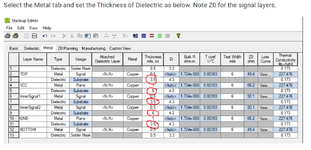engr_joni_ee
Advanced Member level 3
I just for a six layer stack up in Mentor Graphic tool were InterSignal1 (layer number 3) has a reference plane at layer VCC (layer number 2). Should not we always have GND at the reference plane ? For example InterSignal2 (layer number 4) has a reference plane at layer GND (layer number 5) which looks fine. The same reference plane at layer GND (layer number 5) can serve as reference ground for Bottom layer (layer number 6).
But how it goes with InterSignal1 (layer number 3) having a reference plane at layer VCC (layer number 2). Where will be the return path adjacent to signal layer which most text book says.
But how it goes with InterSignal1 (layer number 3) having a reference plane at layer VCC (layer number 2). Where will be the return path adjacent to signal layer which most text book says.
